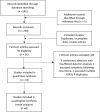Risk factors for recurrent obstetric anal sphincter injury (rOASI): a systematic review and meta-analysis
- PMID: 26676912
- PMCID: PMC4879153
- DOI: 10.1007/s00192-015-2893-4
Risk factors for recurrent obstetric anal sphincter injury (rOASI): a systematic review and meta-analysis
Abstract
Objectives: The objective of this study was to estimate the risk of recurrent obstetric anal sphincter injury (rOASI) in women who have suffered anal sphincter injury in their previous pregnancy and analyse risk factors for recurrence through a systematic review and meta-analysis.
Data sources: A review was performed according to Preferred Reporting Items for Systematic Reviews and Meta-Analyses (PRISMA) guidelines. Searches were made in Ovid MEDLINE (1996 to May 2015), PubMed, EMBASE and Google Scholar, including bibliographies and conference proceedings.
Methods of study selection: Observational studies (cohort/case-control) evaluating rOASI and risk factors were selected by two reviewers who also analysed methodological quality of those studies. Pooled odds ratios (OR) for rOASI and individual risk factors were calculated using RevMan 5.3.
Tabulation, integration and results: From the eight studies assessed, overall risk of rOASI was 6.3 % compared with a 5.7 % risk of OASI in the first pregnancy. The risk in parous women with no previous OASI was 1.5 %. Factors that increased the risk in a future pregnancy were instrumental delivery with forceps [OR 3.12, 95 % confidence interval (CI) 2.42-4.01) or ventouse (OR 2.44, 95 % CI 1.83-3.25), previous fourth-degree tear (OR 1.7, 95 % CI 1.24-2.36) and birth weight ≥4 kg (OR 2.29, 95 % CI 2.06-2.54). Maternal age ≥35 years marginally increased the risk (OR 1.16, 95 % CI 1-1.35).
Conclusion: The overall rate of rOASI and associated risk factors for recurrence are similar to the rate and risk factors of primary OASI. Antenatal decisions could be based on assessment of foetal weight and intrapartum decisions based upon the requirement for an instrumental delivery.
Keywords: Anal sphincter injury; OASI; Recurrence; Subsequent delivery; Third/fourth-degree tear.
Figures
References
-
- Peleg D, Kennedy CM, Merrill D, Zlatnik FJ. Risk of repetition of a severe perineal laceration. Obstet Gynecol. 1999;93(6):1021–1024. - PubMed
-
- RCOG. Third- and Fourth-degree Perineal Tears, Management. Green Top Guideline No 29 1-3-2007
Publication types
MeSH terms
LinkOut - more resources
Full Text Sources
Other Literature Sources
Medical
Research Materials



